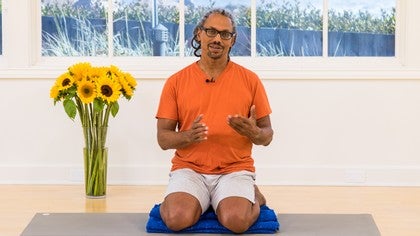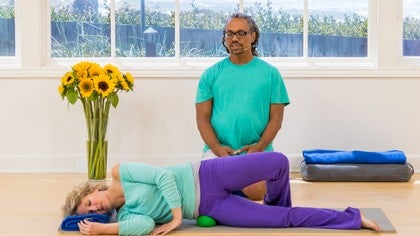Description
About This Video
Transcript
Read Full Transcript
Hi. We're gonna spend a little time exploring the fight or flight response, and then the opposite of the fight or flight response. And afterwards, we'll do a guided meditation. So if you want, you could even set up for the guided meditation now, get comfortable laying on your back with a nice head pillow. Or you can wait until after the talk.
So our body, our body-mind is constantly monitoring the external world, asking this simple question. Am I safe, am I safe, am I safe, am I safe. Am I safe in this situation. Am I safe hurtling down the freeway at 70 miles an hour. Am I safe.
And the potential answers can be, yes I'm safe, or no I'm not safe. When your body-mind understands, no, you're not safe, then what gets stimulated is the survival responses, what's often called the fight or flight response, or the sympathetic nervous system response, and it gets you ready to act right now to get you out of this situation that's not safe. It'll make your heart beat faster. It's gonna change the chemistry of your blood. It'll make all the muscles tighten in your body, getting you ready to run or to fight.
It even changes, slows down your digestion and takes the blood to places where you're gonna need it, to your arms or legs if you're fighting, or if you're running. It's a really great survival tool. Unfortunately, we get stuck in the no side of things. So instead of just having this, no, I'm not safe, we end up with a no that lasts for weeks, months, years, decades. We get stuck in the feeling of not being safe.
And it may even happen at a subconscious level. When we're stuck in that not safe side, then those things that help us survive an unsafe situation can start to lead towards disease. Towards like, high blood pressure, heart disease, diabetes, problems with digestion. There's a lot of diseases that are very common, that the feeling of not being safe is a big contributor. Our culture also values the not being safe.
We value the activity, the getting stuff done, you know, I can rest when I'm dead kind of attitude that's really common in our culture. And because it's so common in our culture, we practice it all the time. What can be really beneficial for us is to start practicing getting away from that fight or flight response. Getting to the place where, instead of, no, I'm not safe, practicing getting to the, yes, I am safe. And the yes, I am safe side of the response changes our body around in the opposite ways.
It slows the heart rate, can lower the blood pressure. It stimulates digestion. You've probably felt that when you've been receiving a massage and about 20 minutes into the massage, blub blub, your stomach starts going off. That's a really good sign. It means you're relaxing.
It's a sign that you're getting to that place where your body and mind knows that you are safe. So there are some things that we can do to practice getting to the yes, I am safe place. One is meditation. Meditation helps our body-mind get the perspective of what's happening right now, and helps us practice getting into this moment right now that is safe. Another is doing physical practices like yoga.
Doing the movement with the breath. Twisting and releasing the tension that may be stuck in the body-mind. Getting that movement the happen helps to decrease the stuckness, the stagnation that can be within our bodies. And another is the breath. The breath is a really great tool, because the belly breath that we're gonna do now is a direct stimulant to the rest and digest side of the nervous system responses.
So if you haven't gotten onto your back, go ahead and get comfortable, on the floor or on the couch. Something under the head, so your head and neck feel great. And your knees can be bent if that feels better, or your legs can be out straight. Bring one hand onto your belly. You're gonna use the hand on the belly just to monitor the breath.
And take an inhale, and as you inhale, draw the breath down into the low belly, so your belly expands. We're getting the diaphragm to drop down, and the belly expands on your inhale. As you exhale, the belly comes back down towards the earth. Notice if, when you inhale, your chest is expanding. That's not quite what we're looking for.
We're looking to get the breath to drop down in the low belly on the inhale, then come back down towards the earth on the exhale. As you inhale, the belly expands. As you exhale, the belly comes back down towards the earth. A few more times. Inhaling, the belly expands.
Exhaling, the belly comes back down towards the earth. Belly expands on your inhale. Comes back down towards the earth on the exhale. And you can continue breathing like that, belly expanding on the inhale, coming back towards the earth on the exhale. We can also add, along with the breath, the power of the mantra.
Just making a simple mantra that helps bring that knowledge, that resonance of safety into all the layers of your body-mind. So the next time you inhale, belly expands, as you exhale, say out loud, I am safe. Inhale, and as you exhale, I am safe. On each exhale, I am safe. And let that resonance of the sound, the truth of that knowledge that, I am safe, let that vibrate through your chest, through your belly, through your bones, with each exhale.
I am safe. I am safe. I am safe. I am safe. I am safe.
I am safe. For the next few breaths, let that resonance continue in silence. As you breathe in and out from your belly. Acknowledge that right here, right now. I am safe.
(heavy exhaling) You're welcome to rest here, take a shavasana, a final relaxation, resting in this vibration of, I am safe. And if you're ready to come up to seated, bring a little movement into your fingers and toes. Slowly roll your way onto one side, drawing your knees up towards your chest, pausing on your side for a couple of breaths. And from your side, let your head stay heavy. Roll a little forward and press your hands down, slowly rolling up your spine, one vertebrae at a time.
Your head's the last thing that comes up. And find a comfortable seated position. I hope you can enjoy the tools that practice, expanding the feeling of safety within yourself, and you can share that feeling with those around you. Namaste.
The Happy Back Show: Low, Mid, and Upper Back Relief
Comments
Arturo
You need to be a subscriber to post a comment.
Please Log In or Create an Account to start your free trial.









